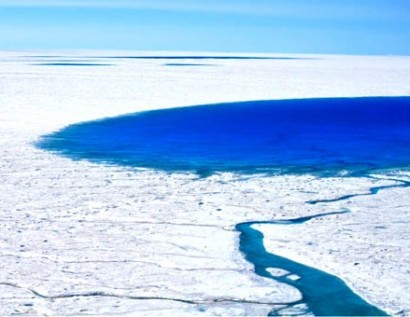Scientists finally have an explanation for why huge lakes atop Greenland are vanishing
 Back in the summer of 2006, scientists studying the vast and in some places mile-thick Greenland ice sheet observed something that can only be called breathtaking. Due to meltwater, lakes form atop the ice sheet in the summer – scientists call them “supraglacial lakes” — and they can grow to be quite large. And in July 2006, one large lake, over 2 square miles in area, suddenly vanished. It lost most of its water in under two hours – researchers calculated that the rate of drainage “exceeded the average flow rate over Niagara Falls.” There was only one place all that water could have gone – down into the ice sheet, where researchers feared it could lubricate its base and hasten its slide into the ocean. Little understood phenomena like this, they wrote, could add to the dynamism and rapidity with which Greenland – which contains enough ice to raise sea levels 20 feet – responds to global warming by melting and pouring water into the ocean. Now, many years later, scientists from MIT, the Woods Hole Oceanographic Institution and several other universities – including a number who wrote that original study – think they’ve explained how these great glacial lake vanishings happen. And they’ve done so by studying that same, rapidly vanishing lake from 2006 – North Lake, they call it. The new research, published today in the journal Nature, finds that gigantic cracks open beneath some meltwater lakes precisely because water has already gotten underneath the ice sheet from elsewhere – lubricating it and making it slip. This, in turn, cracks open new pathways that inject still more water below the surface, further helping ice to slide seaward. “We’ve found a mechanism that demystifies what’s happening,” says Laura Stevens of MIT and Woods Hole, the study’s lead author. “We know that the ice sheet will continue to increase its contribution to sea level rise over the coming years. The implications of this study show us more of how these processes will play out.” The research required Stevens and her team to install 16 GPS devices all around the gigantic North Lake, situated atop nearly kilometer-thick ice in a region of West Greenland close enough to the ice sheet fringe that it is actually considered a “coastal” area (the ice grows far thicker inland). The lake, says Stevens, was only 20 or 30 feet deep (when full), but the water it contained “would fill up 4,000 Olympic swimming pools.” The researchers wanted to figure out how a gigantic crack opens beneath a lake like this one, since only about 13 percent of meltwater lakes atop Greenland actually have been observed to drain rapidly in summer (cracks can close in winter, and the lakes can refill – and re-empty – again the next summer). And the much denser GPS instrumentation let them do so: Between 2011 and 2013, they observed, prior to lake drainage events, something else happened – namely, ice in the region near North Lake rose in elevation and also increased its movement seaward. This was likely caused by water somewhere else getting to the base of the ice sheet. “Essentially what we see is, in the hours before the lake drains, a couple of the [GPS] stations are uplifted and move a little bit faster than the array,” says Stevens. “The water is getting down to the bed, and if you get enough down there to overwhelm the plumbing system, you can jack up that region of the ice sheet. You float a portion of the ice sheet – on the surface, that translates to that portion of the ice sheet moving up, and the ice is now stretched.” This creates tension in the region of the lake, adds Stevens, allowing cracks to form underneath it – what they researchers call a “hydro-fracture.” So how did water initially get to the base of the ice sheet before the lake itself started its rapid drainage? The answer seems to be a pre-existing “moulin,” a hole where water flows downward that has been likened to a “vertical ‘river’ ” – part of the glacial “plumbing system” described by Stevens. In this case, there was a known moulin in the vicinity of North Lake. And then come the fireworks – as the lake actually drains. “You hear large cracks and booms,” says Stevens. “You hear a lot of water rushing, kind of a sound of a large waterfall, and even, one to two kilometers away from the lake drainage, you see a lot of microcracks running through the surface of the ice sheet, maybe a millimeter wide.” All of which is pretty terrifying – but in some ways, the study notes, this mechanism actually presents some good news. That’s because it suggests that meltwater lakes do not simply vanish of their own accord or under their own weight. Rather, they probably have to lie in a region where there’s another preexisting pathway for water to get under the ice in large amounts. This, in turn, means that many meltwater lakes, including those in higher elevation regions of the ice sheet where there is a greater vertical distance to its base, may not be prone to sudden drainage. Rather, the water pooled in these lakes may still eventually drain and get to the ocean, but not by going straight downward. Rather, it is more likely to run along the ice sheet surface in streams until it reaches more coastal regions, where moulins or rapid lake drainages carry it down and out. And that means inland parts of the ice sheet may not move as fast as coastal parts. “With increasing temperatures we’re seeing more and more lakes forming on the ice sheet’s surface, but the immediate velocity response inland we may not see, because they’re getting their water to the bed elsewhere,” says Stevens. |


















